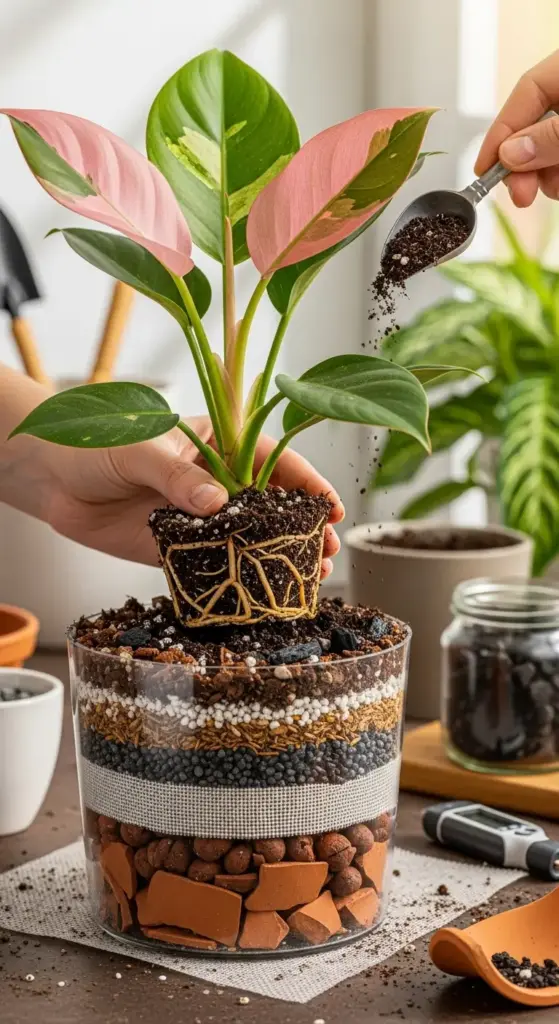2. The Secret Soil Amendment That Changes Everything

I’m about to share something that literally revolutionized my Pink Princess care – and it’s probably going to make you want to repot your plant immediately.
For two years, I watched my beautiful Pink Princess struggle in what I thought was “premium” potting soil. The variegation was inconsistent, growth was slow, and I couldn’t figure out what I was doing wrong.
Why Standard Potting Mix Is Sabotaging Your Pink Princess
Here’s the brutal truth: most commercial potting mixes are designed for basic houseplants, not the specific needs of variegated philodendrons. They hold too much moisture, don’t provide adequate aeration, and lack the organic matter these plants crave.
Standard mixes typically contain around 60-70% peat moss or coconut coir. That might work for your pothos, but Pink Princess roots need way more drainage and air circulation.
I learned this after losing my first Pink Princess to root rot – despite following every watering guide religiously. The soil was the problem all along.
The Professional Grower’s Soil Recipe (My Secret Formula)
After months of research and trial-and-error, I developed this custom soil mix that completely transformed my plant’s health. Here are the exact ratios I use:
- 40% high-quality potting soil (I use Fox Farm Ocean Forest)
- 25% perlite for drainage and aeration
- 20% orchid bark (medium-sized chunks)
- 10% worm castings for slow-release nutrients
- 5% activated charcoal for toxin absorption
This blend creates the perfect balance of moisture retention and drainage that Pink Princess plants absolutely love. The organic components break down slowly, feeding your plant over time.
Mycorrhizal Fungi: Your Plant’s Underground Best Friend
This is where things get really exciting. Mycorrhizal fungi form a symbiotic relationship with your plant’s roots, essentially creating an underground network that dramatically improves nutrient uptake.
I add about 1 teaspoon of mycorrhizal inoculant per gallon of soil mix. These beneficial fungi attach to the roots and extend their reach by up to 1000 times – seriously, it’s like giving your plant a supercharged root system.
The difference in growth rate and variegation quality after adding mycorrhizae was honestly shocking. My Pink Princess went from producing one new leaf every 6 weeks to one every 3 weeks.
pH Buffering Techniques for Consistent Growth
Pink Princess Philodendrons thrive in slightly acidic soil with a pH between 5.5-6.5. Most standard potting mixes are too alkaline, which blocks nutrient absorption even when you’re fertilizing correctly.
I add 2 tablespoons of sulfur powder per gallon of soil mix to naturally lower and buffer the pH. This creates consistent conditions for optimal root health and nutrient uptake.
Testing your soil pH every few months is crucial – I use those cheap digital pH meters from Amazon. Trust me, it’s worth the $15 investment.
Creating the Perfect Drainage Layer System
Here’s my drainage layer technique that prevents root rot without creating a desert environment. At the bottom of every pot, I create a 2-inch layer using:
- Large leca balls or broken pottery pieces
- A thin layer of landscape fabric to prevent soil from washing down
- My custom soil mix on top
This system allows excess water to drain freely while maintaining the moisture levels that Pink Princess plants need for healthy growth. The fabric prevents the soil from becoming waterlogged while keeping beneficial moisture available to the roots.
I’ve never had root rot issues since implementing this layering system. It’s honestly foolproof.
Want to know the advanced pruning technique that triggers explosive variegated growth? Hit that “next” button to discover the pruning psychology secrets that professional growers use – including the controversial “stress pruning” method that sounds crazy but produces incredible results!









GIPHY App Key not set. Please check settings